The fifteenth webinar of a series "Grounding and lightning protection: issues and problems arising in the design"
Webinar text. Page 3
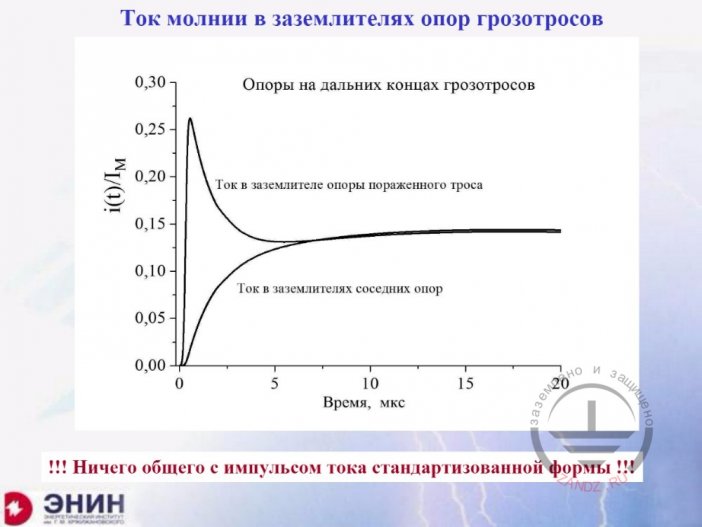
Lightning current distortion
Опоры на дальних концах грозотросов – supports at the extreme ends of ground wires
Ток в заземлителе опоры пораженного троса- current in the ground electrode of the damaged wire support
Ток в заземлителях соседних опор – current in the ground electrodes of the neighboring supports
Время, мкс – time, ms
Ничего общего с импульсом тока стандартизованной формы – nothing in common with the current pulse of the standardized form
- On this chart, just a current through ground electrodes is shown; it doesn't repeat the lightning current. It is completely different and this distortion of the lightning current is given to us by the inductances of the circuits which these fronts smash up. All this should be taken into account in the calculations.
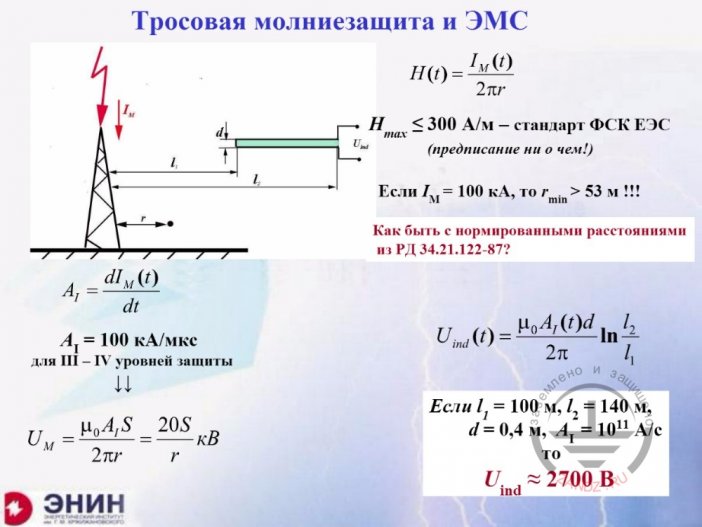
Catenary wire lightning protection and electro magnetic compatibility
Стандарт ФСК ЕЭС – FGS UES standard
Предписание ни о чем – Prescription about nothing
Как быть с нормированными расстояниями из РД – What to do with the standardized distances from AD
Для III-IV уровней защиты – for III-IV protection levels
- And now the situation which we are going to study. Let's compare catenary wire lightning protection with the protection of a rod lightning rod, but we will compare it only by electro magnetic pickups. What is recorded in the rules? The strain of the magnet field in the place where electronic equipment is installed, any secondary equipment should be not greater than 300 A/m. If I take a rod lightning rod and study a lightning strike into this rod lightning rod, we will get the following thing. If I take an ultimate lightning current for the 3 and 4 level of lightning protection according to IS-153 it is 100, and this is the current to count pickups with, we will get the following. In order for the field strength to reduce to 300 A/m, I need to move away from the lightning rod over the protected object to 50 meters or more. If I move away from the lightning rod to 50 meters, it will be hard to imagine this lightning rod, because its height will be more than 100 meters so the object gets into the protection zone.
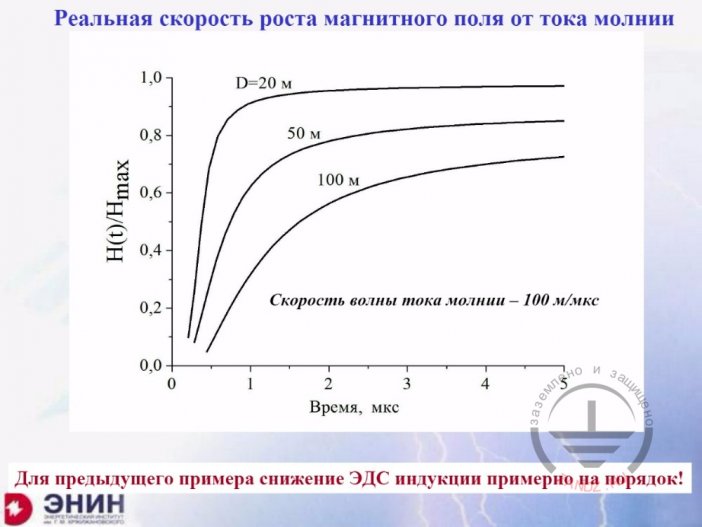
Real rate of magnet field growth from a lightning current
Скорость волны тока молнии 100 м/мкс – lightning current wave speed 100 m/ms
Время, мкс - time, ms
Для предыдущего примера снижение ЭДС индукции примерно на порядок – for the previous example, reduction of EMF induction is about to an order of magnitude
- If I start to study catenary wire systems, I will get this. Firstly, the currents are divided to the left and to the right by the wires. The currents are divided by the supports. And finally, the operation of inductance, which smash up fronts of all these currents.
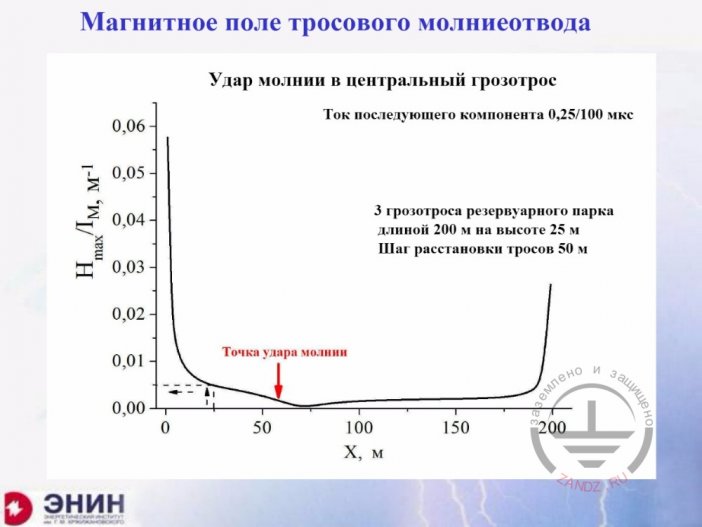
Magnetic field of a catenary wire lightning rod
Удар молнии в центральный грозотрос – lightning strike into the central ground wire
Ток последующего компонента 0,25 – 100 мкс – current of the next component 0,25-100 ms
3 грозотроса резервуарного парка длиной 200 м на высоте 25 м – 3 ground wires for the tank farm 200 long at the height of 25 m
Шаг расстановки тросов 50 м – distance between the wires 50 m
Точка удара молнии – lightning strike point
- If to count all these circumstances and see what pickups we get and what magnet felds arise in the systems with catenary wire lightning rods, the following thing happens. If I take and remove the whole system to 20 meters from the protected territory, then the pickups which appear in the circuits will drop from the level of 1 kV to about 100 V.
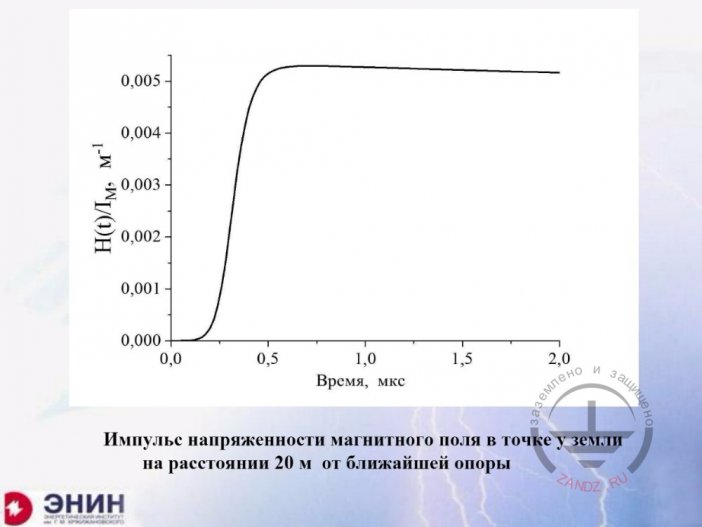
Magnetic field strength pulse
Время, мкс – time, ms
Импульс напряженности магнитного поля…- Voltage field intensity pulse at the point at the ground at the distance of 20 m from the nearest support
- That means the level of pickup, application of a catenary wire lightning rod reduces to 10 times approximately because the current pulse becomes more flat and the pickup becomes shorter.
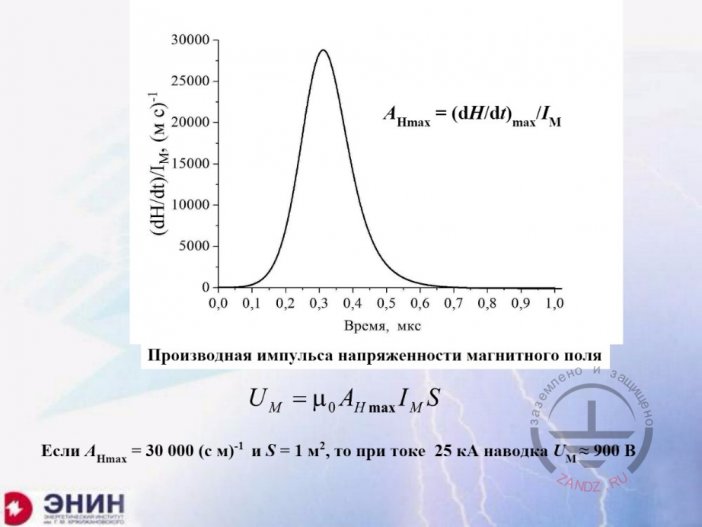
Magnet field strength pulse derivative
Производная импульса напряженности магнитного поля – Magnet field intensity pulse derivative
Если А…- If A
То при токе 25 кА наводка 900 В – then with the current = 25 kA, the pickup will be 900 V
- Its duration is at the level of a tenth share of microseconds, and the level of this pickup reduces to the order of magnitude. That is why, it is recommended to use catenary wire lightning protection in order to reduce the level of electromagnet pickup on the protected territory, be it electric substation, or station, or tank farm or an office building. In any situations the pickup which appears at the protection of a catenary wire lightning rod, reduces significantly. It can be brought to the level of about 100 V in the circuit 100-150 meters long. What to do then?
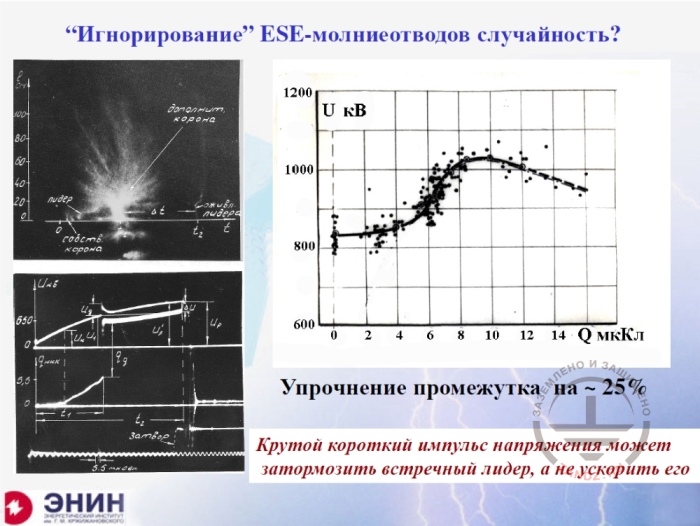
Shielding of utilities
Игнорирование ESE молниеотводов случайность – Ignoring of ESE lightning rods is an occasion
Упрочнение промежутка на 25 % - hardening of the gap to ~ 25%
Крутой короткий импульс напряжения может затормозить встречный лидер, а не ускорить его - Steep short voltage pulse can slow down the counter leader, not to speed it up
- And then it is necessary to start shielding protected circuits. What protection can be talk about? We can talk about metal shields. This chart shows the order of shielding of electromagnetic pickup with the help of a cable with copper armor - it is a cable of a television type, or a cable the armor of which is made by a tape over a core, or a steel tape. How does it relate to the efficiency of protection of such shields? We need to orient to two frequences.
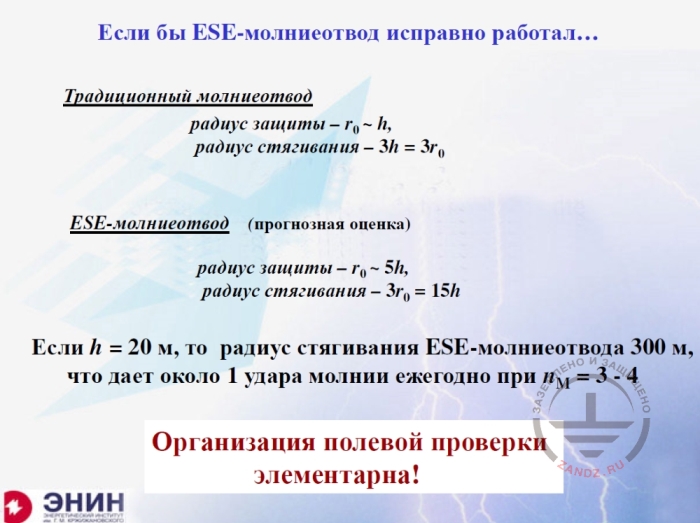
Shielding ratio
If ESE lightning rod would function properly…
Conventional lightning rod
Protection radius
Contraction radius
ESE lightning rod (forecast estimation)
Protection radius
Contraction radius
If h=20 m, then contraction radius of ESE lightning rod is 300 m, which gives about 1 strike annually at n(m) = 3-4
Organization of field test is elementary!
- What can be such additional shielding? Laying of high-frequency circuits either in cable trays or in steel chanels, or concrete flumes put in the ground can be such additional shielding. Look, at the frequency of 1 MHz their action is very weak, it is again at the level of ten. But I will show you why. The shielding ratio multiply and if you take 10 at the expense of cable screen and somewhere about 5-10 at the expense of the flume, you will get the multiplication order 10*5 it is 50 and 100 V of pickup and only 2 V will remain, which is a safe pickup. Catenary wire lightning rods allow to get along with only electromagnet shields in the majority of practical situations without the use of any SPDs, which cost quite a lot and are quite hard in use. And this advantage of catenary wire lightning protection systems is the most important to my mind and the most crucial today, when the main losses from lightning impact go through electromagnetic pickups.
Questions and answers
-I would like to finish at that point. If you have any questions, I am ready to answer them.
-Thank you so much for the report. Dear colleagues, you can write your questions in the chat. I see one question already. I will read it out loud and we will try to answer it. Victor is asking: " When the lightning current flows through the down conductor, it will be heated and the materials of the down conductor will get longer. How to compensate such extensions correctly - flexible steel tapes? Or they should not be compensated? Because after a lightning strike it may be necessary..."
- You know what.
-"Grounding contour of lightning protection and protective grounding of a building should be united?" It is a very popular question, it is asked at every webinar.
- According to the IEC protective grounding and lightning protection grounding should be united into one contour, but it is "as a rule", because then we read - if some technological ideas do not prevent from that.
- "When is it planned to publish the new document on lightning protection? And will it cover the use of ESE lightning protection?"
- I am answering the question. If you were at the recent conference on lightning protection, which took place this May in Saint-Petersburg, you would see how many reports were presented for the improvement of the regulatory base of Russia. In the solution of this conference the following thing was written - that the conference addressess to the Academy of Science with a request to organize a special committee at the Russian Academy of Science on the improvement on this regulatory base. I can answer you how the things go now. The president of the Academy of Science - Vladimir Evgenievich Fortov agreed to sign a letter and send it to the main departments of Russia that is energetics, transport, aviation, oil and gas production so to collect this document all together. Form a comittee to make this regulatory document. It is clear that it won't appear this year. I think it won't appear next year either, but the work began.
-Thank you. Eduard Meerovich, there are two questions here. But I will ask the last one, because it relates to what has been discussed now. Victor comments: "As a rule, it is said in the IEC too. It should be done, but there can be exceptions. It is possible to give ground to the union of two different ground electrodes, indicating great values of step voltages on an ordinary contour laid near the building, to pedestrian routes, with a possible danger to people?"
- Yes, of course. And we worked on the following. Here is an office building of ordinary sizes, something like 50 to 20-15 meters. There is the foundation in the form of a ground electrode. Reinforced concrete foundation in the form of a technological ground electrode and lightning protection ground electrode is used. Moreover, along the perimeter of the building a recommended closed contour is laid, which goes from the horizontal bus at the distance of about one meter from this foundation- all this is done and we count step and touch voltage now. I assure you these gifures are much greater the value of 6 kV, which is today discussed as being safe in our guidelines on the arrangement of grounding devices. It is simple to justify it.
- "Hello, could you please tell about the area of using ground wires below the wires of air lines and counterweights".
- You know what, I don't know where ground wires below the power transmission wires are applied. Such questions were discussed somewhere in the 30s of the former century. It was so, but today these questions do not arise. But we can talk about counterweights. What a counterweight is?
- Thank you, Eduard Meerovich. Another question from Konstantin from Kaliningrad:"Please tell how to count touch voltage appearing between the metal support and ground providing the support is installed in a concrete foundation and has no metal connections to the ground. What method to apply?"
- How can it not have metal connection to the ground? If it stands on a concrete foundation, then the support has a metal connection to the ground via this foundation. Because concrete had been thoroughlt studied by the Research Institute of reinforced concrete, there are very many serious works on that issue. In particular, you can find the works of Karyagin, they are really good. So the essense of these works is as follows. If your concrete lies in the ground for 2 month, then the conductivity of the surrounding ground and of the concrete which absobed moisture from the ground is almost equal. And all metal fittings of the reinforced concrete foundation of the support, and the support itself, is in the ground. There is no need to have concrete in the calculation. Your fittings rods are all in the ground. But you simply count ground resistivity, distribution of potential, there are many programs like that and you will get the difference of potentials between the support and the point which stands from the suppoty at the distance of 1 meter. This is potential difference, it sents the touch voltage. Touch voltage is equal to the difference of potentials between the metal grounded element and the person who stretched his arm. It is considered that his arm is 1 meter and he touches the reinforced concrete base.
-Thank you. Viktor left another comment about the difference of the regulatory documents:" Is it possible to apply GOST IEC which consists of five volumes; it means it covers the experience of the European scientists, why to think of something new?" Can you comment on that?
- I can, with great pleasure. First of all, we had a seminar on that topic and we showed there that our Russian experience is different from the European one. To my mind, the European experience in external lightning protection very strongly lags behind the one made in Russia. I can bring many examples, but I don't think it is necessary to do that. The seminar, the webinar on IEC standard, about external lightning protection can be found on the Internet. It is available and you can watch it with all the presentations. And you will see the serious shortcomings of IEC standard. Now there is the second part of this standard, it concerns everything called internal lightning protection and in fact, it is the question of electromagnet compatibility. We did not discuss these questions at the seminar. I think we should discuss them. What is good there? These good things are already introduced, for example IS-153 and AD -34.21.122. And to my mind there is something inadmissible there. You know I can reveal you only one thing.
- We are up to any webinar. We will talk about it after the webinar and we think there will be no problem to hold one. Dear colleagues, I sent the link to the recording of the webinar we've been talking about to the chat. The national regulatory documents and IEC documents were discussed during it. Please watch the video recording, it is available.
-I understand that the questions are over?
- Nope, we still have some.
- A guest is asking a question:"Are the requirements for the calculation of height of a free-standing catenary wire lightning rod and catenary wire lightning rod installed on the protected object identical. What is the influence of electromagnetic force on the equipment inside the object in this case?"
- You know, now the requirements in our national regulations are identical. They are equal, but I think your question is reasonable. Because they are equal only because we can't consider the influence of the building roof on which these lightning rod stand now. They are idential now, but only for "now" - due to the fact that the calculation is simple, the protection is more reliable, but it will be necessary to divide it early or later.
-Thank you. Alexander is asking a question:"Is it true that the geometry of the ground electrode is more important than its resistance?" I think you mean configuration, saying geometry?
- Let me give you an example. Imagine you have rolled iron and you are going to make a grounding contour of it. You can take this rolled iron and lay it in the form of some mesh on some area. It will be one marginal variant, and another marginal variant - you will take the same rolled iron and make one single tape half a kilometer long. You used absolutely equal quantity of iron to make a contour. But what will you get?
- Thank you, Eduard Meerovich. While we were answering we recieved another question from the guest: "What do you use IS-153 or AD-34 calculating protection zone of rod and catenary wire lightning rods? The difference of lightning rods is 1,5 times".
-That's right. There was a talk on that topic. Is-153 gives a precise protection reliability which is guaranteed by three types, three lightning protection elements: reliability 0,9, 0,99 and 0,999. And the protection zones given in IS-153 correspond to these reliabilities. If you fill this zone completely by the object, the reliability will be not lower the one mentioned. And if the zone is partially empty, it will be high. There is no protection reliability in the zones which are given in AD-34. There is zone A and zone B. If you dig in this book AD-34, you will find a text which is not a rule. And this text from the name of one of the authors of AD-34 prescribes certain values of reliability of protection of zone A and zone B. These figures were checked and it was found out that there is a big mistake there. In fact I remember the difference for the zone B instead of the promised 0,95 was 0,85. It is an immense difference. And that is why, it is possible to use AD-34 zones, but you should remember that their reliability is completely uncertain. The reliability is indicated in IS-153. But if to talk about me personally, I am not using any of the zones, and I do not advice you to use them. Because the reliability of protection should be counted using software, then you will precisely know, how many "grams to weight".
- Alexander specifies about geometry: "Saying geometry he means surface, not deep grounding. Lightning takes the charge from the surface, not from the depth.
- I don't know such a word "surface grounding" for a simple reason. Because we have grounding electrodes, and we usually ground the ground for half a meter at least. There are only exceptions in IEC referring to rock soils. In rock soils it is allowed to place ground electrodes up to 20 cm deep because the layer of the soil is not great there, and below goes the massive rock. That is why, I don't know what a surface ground electrode is. 50 cm is a minimal depth, minimal.
- Alexander, have we answered your question? If not, I am offering to contact me by email after the webinar and I will answer that question in more detail.
- So? Let's finish.
- Yes, let's finish. Eduard Meerovich, we have the last question here, if you don't mind.
- OK.
- The guest comments: "Me and my colleagues have a question how to calculate the resistance of the ground electrode foundation made of reinforced concrete cube (written) of a free standing lightning rod- as given in a sphere, in the ground or in a semi-sphere on the ground surface?"
- You need to consider that the fittings of reinforced concrete foundation of lightning rod support is in the ground. It doesn't matter of what shape this concrete support is. I would like to underline once again. Only rods in concrete function. The fittings do not function. Fittings rods and it is necessary to calculate. Forget about concrete at all. Concrete laying in the ground is the ground itself.
- Thank you, Eduard Meerovich. Now the questions are over.
- Colleagues, I am an open person for "IMAG" company and for all of you through this company. If you have any certain questions, send them to "IMAG", I will get them and I promise you to answer them 100% if I know what to answer. Because there might be questions I simply don't understand. I don’t know, if to be exact. Thank you very much for your attention!
- Dear colleagues, if you have any questions about this webinar or any other questions on design of lightning protection and grounding, please send them to our email address, you can see it in the chat.
Do you have any questions left? Send them to our technicians and you will get detailed answers.
<< Previous Page
Slides 9 to 16
Related Articles:
 Lightning Protection of Large Territories: Parks, Grounds, Plant Territories. Page 1
Lightning Protection of Large Territories: Parks, Grounds, Plant Territories. Page 1
 Lightning Protection of Large Territories: Parks, Grounds, Plant Territories. Page 2
Lightning Protection of Large Territories: Parks, Grounds, Plant Territories. Page 2
 Lightning Protection of Large Territories: Parks, Grounds, Plant Territories. Page 3
Lightning Protection of Large Territories: Parks, Grounds, Plant Territories. Page 3

